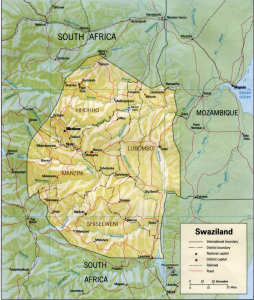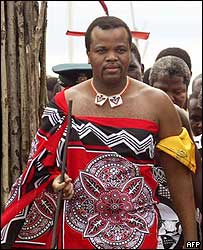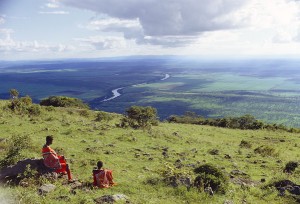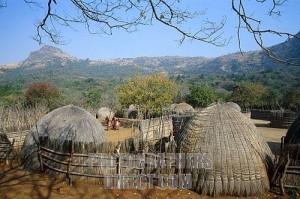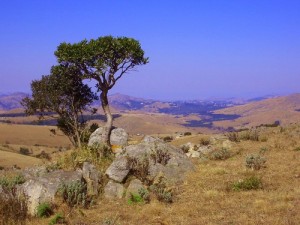The Kingdom of Swaziland (part 2)
Yesterday I posted about the decision Beth and I have made about moving to Africa. Today I want to take the time to give a brief overview of the country of Swaziland, where we are strongly considering moving. Tomorrow, I will write a bit about why Beth and I made this decision and what it may look like.
Swaziland is the second smallest mainland country in Africa (trailing only Gambia). It is landlocked and roughly the size of New Jersey. It lies to the north-east of South Africa and is surrounded on three sides by that country. Southern Mozambique is along the eastern border of Swaziland. The population of the country is 1.1M, which is about the same as Rhode Island (by comparison Kentucky has a population of 4.3M). That gives a population density of roughly the same as Tennessee, but the differences is that Swaziland is more spread out with its capitol and largest city of Mbabane having only 81,000 people. Only 4 cities have more than 10,000 people and only 10 are over 4,000.
The country has a rich history and remains as the only remaining monarchy in Africa. Currently King Mswati III is the ruler of the country. He currently has 14 wives and 23 children. Swaziland is navigating a fine line between democracy and monarchy with a (relatively) newly adopted constitution. In the early 1800’s the Dlamini royal house established themselves in the area. By the turn of the next century, the area known as Swaziland was under British colonial rule even though the royal family was still in existence. In 1968 the country was granted independence and a constitutional monarchy was established. This however was short lived as in 1973 the constitution was dissolved by King Sobhuza leading to a absolute monarchy. Eventually the monarchy was passed on to the current king Mswati III in 1986. Under his rule (and thorough the pressure of underground political parties) a movement to more democracy was initiated. National elections begain in 1993 and in 2006 a new constitution was established that declared the king the head of state and a prime minister and parliment along with a judicial system under him. While power is now shared, the king still has an abundance of control (for instance, all the land is considered to be the King’s).
Swaziland has two languages, siSwati and English. SiSwati is the traditional langauge spoken in most of the rural areas and English is the language of business and government. SiSwati is a derivitive of Zulu; you can hear it spoken here.
By far the greatest issue facing the Swazi people is the AIDS epidemic. Currently nearly 40% of adults are infected that number is on the rise. According to the UN, it is one of the few areas of the world where the quality of life is decreasing. The AIDS rate is the highest in the world, the life expectancy is the third worst, and of 177 countries, it listed as being 141st in terms of human development. 77.8% of the population lives on less than two dollars a day and 47.7% lives on less than a dollar.
Despite these staggering problems and a transitioning government, Swaziland is relatively stable. There are not major uprisings, civil conflicts, or major border disputes. There are not rebel groups attempting to overthrow the government like there are in other African countries.
The crime rate in Swaziland is relatively high, especially in terms of violent crime. However, it should be noted that its overall crime rate is 20% lower than that of the United States. This compilation report highlights crime statistics as well as human rights issues, which I will address next.
While Swaziland is a stable country, it does have major human rights issues as this detailed report from the State Department explains. Here is part of the the abstract (emphasis mine):
Swaziland is a modified traditional monarchy with executive, legislative, and limited judicial powers ultimately vested in the king (Mswati III). The king rules according to unwritten law and custom, in conjunction with a partially elected parliament and an accompanying structure of published laws and implementing agencies. The population was approximately 1.1 million. The most recent parliamentary elections, held in 2003, were not considered free and fair. Political parties continued to be banned. Political power remained largely with the king and his circle of traditional advisors, including the queen mother. The civilian authorities maintained effective control of the security forces; however, there were some instances in which security forces committed abuses.
The government’s human rights record was poor, and government agents continued to commit serious abuses. The country faced a serious socio?economic situation characterized by sluggish economic performance, poverty, drought, an HIV/AIDS prevalence rate of 42.6 percent, and growing unemployment. The following human rights problems were reported:
- inability of citizens to change their government
- arbitrary killings by security forces
- police use of torture, beatings, and excessive force
- police impunity
- arbitrary arrest and lengthy pretrial detention
- infringement on citizens’ privacy rights
- limits on freedom of speech and of the press
- restrictions on freedom of assembly and association
- prohibitions on political activity and harassment of political activists
- restrictions on freedom of movement
- discrimination and violence against women
- poor enforcement of women’s rights
- child abuse
- trafficking in persons
- societal discrimination against mixed race and white citizens
- antiunion discrimination
- child labor
I want to end on a bright note. The country of Swaziland is absolutely beautiful with high plains, majestic mountains and pristine valleys. I have included some pictures below.
Finally, here are a few websites I have found useful in addition to those linked above:
- The World Factbook — Swaziland – detailed information on Swaziland by the CIA.
- Times of Swaziland – Swaziland’s only independent newspaper.
- Swaziland Commentary a blog about the political situation written by a professor of journalism at the University of Swaziland.
- U.S. Embassy Mbabane, Swaziland – Home – US Embassy in Mbabane.
- Swaziland – US Department of State website on Swaziland
- Peace Corp Pre Departure Material – Language lessons for siSwati provided by the Peace Corp.
See Also:
